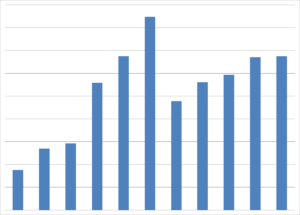
That’s not a chart, it’s s a castle
Yesterday evening I was reading financial reports of a company I am considering to invest in. While I was studiying the chart of that company showing the development of the stock price of the last months, my son came to me and asked what I was looking at.
“That’s a chart.” I said.
My son replied with a smile: “No dad. That’s a castle”.
That made me laugh. How cute! And indeed, I could immediately recognize the resemblance, just think of the castles shown in Disney films. Interstingly, all of a sudden I could see much more: a mountain range, a skyline, a fire, icicles, a cave with stalagmites and so on.
What I nice reminder that each thing and each experience in life can be looked at from various perspectives.
Thinking outside the box
Education, worklife and daily routines over time let us unlearn our essential ability to look at things from different perspectives which leads to an extremely one-dimensional thinking. To a certain degree this makes us stuck.
We tend to limitate ourselves.
Just take as an example the general concept and deeply rooted set of beliefs in our society “expecting” that someone has to
- immediately “find” a job after school, university etc.
- work eight to nine hours a day
- work until he or she is 65 (or even longer)
- work hard, be ambitious and loyal towards the employer and in exchange get a good salary
- use almost the entire salary to consume and feel good about that
Where are the limitations when you look at the points above? They lie in the assumptions that someone
- does not have many other purposes in life other than working and consuming
- wants to depend on an employer and wants to get a job instead of creating opportunities (for example by pursuing the path of an entrepreneur and/or as an investor)
- does not invest in productive assets and therefore the salary is the only source of income
- increases spendings for consumption over time and consequently has a falling savings rate (if any)
- relies on an ever growing salary which leads to high dependency on a job
There is a high probability that these general assumptions are not applicable to all of us and yet they seem to set the framework for our lives.
There are many cool alternatives
I know people who earned a salary far below average and nevertheless were able to stop working at the age of 50 years to travel the world. Some of them were even much younger when they quit their job. How is this possible?
In fact it is quite simple: they aligned their spendings, led a down to earth lifestyle and invested wisely. They took a decision and chose a different pathway to become financially independent instead of “working in order to consume for decades”.
So the basic concept of working “9 to 5” for almost the entire life is just one way of life. There are uncountable other possibilities.
Breaking limitations
Looking at things from different perspectives is extremely refreshing and shows us plenty of options. Thinking outside the box is the base for creativity, the ability to address challenges with new ideas and solve complex problems. It’s a different learning process than through emulation and memorising facts.
We all have choices and can have an influence on many variables. We just have to relearn to see them. If you don’t want to work for decades and pursue something you are really passionate about, you can go for it. It is possible. It’s all a function of how much you need to live well, how much money you accumulated and how hard that stash is working for you. In a nutshell it boils down to the savings rate.
It is the right and duty of each of us to take control of our life, take care of our loved ones, to pursue our dreams, rise to the top of our capabilities and to find fulfillment.
